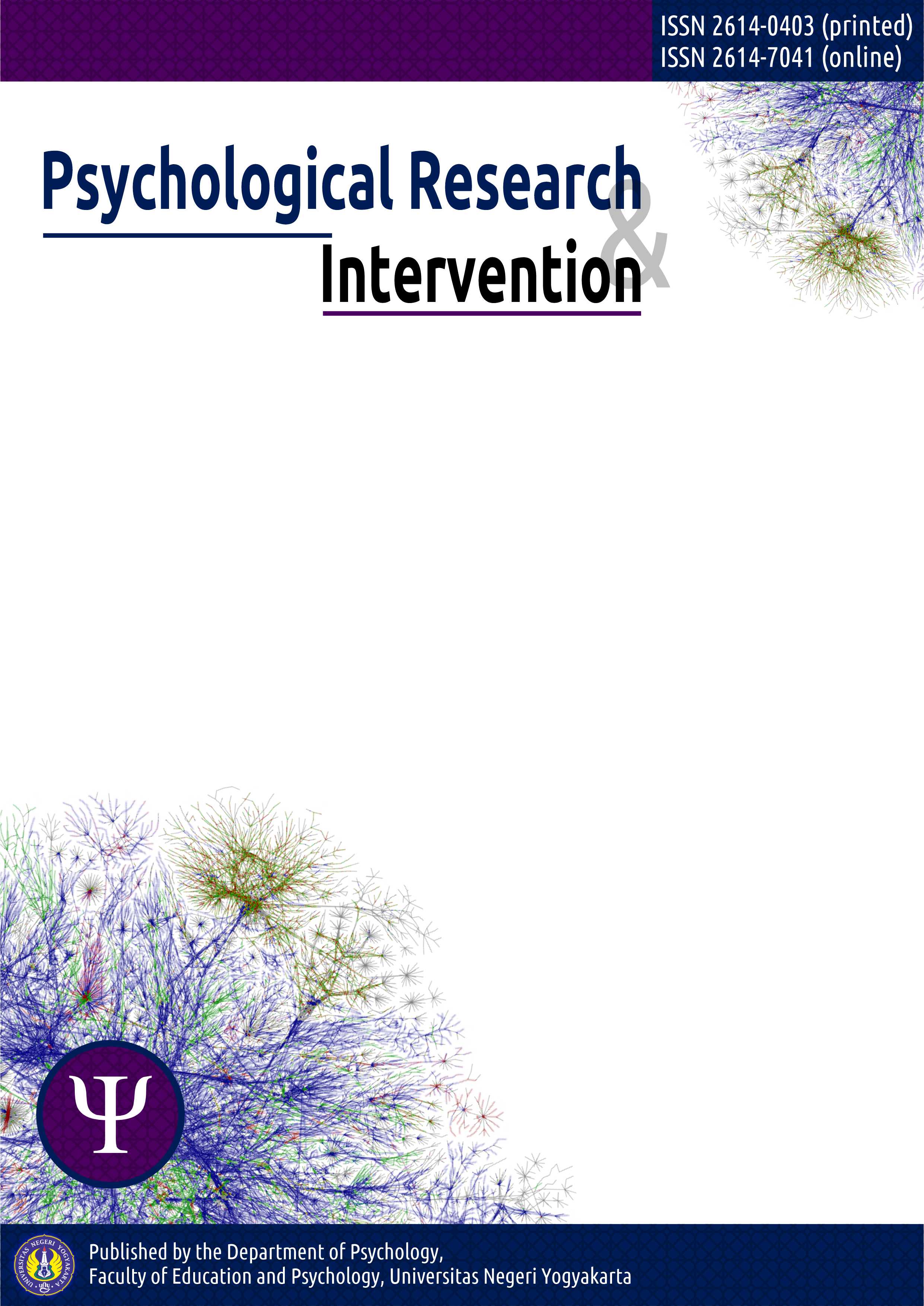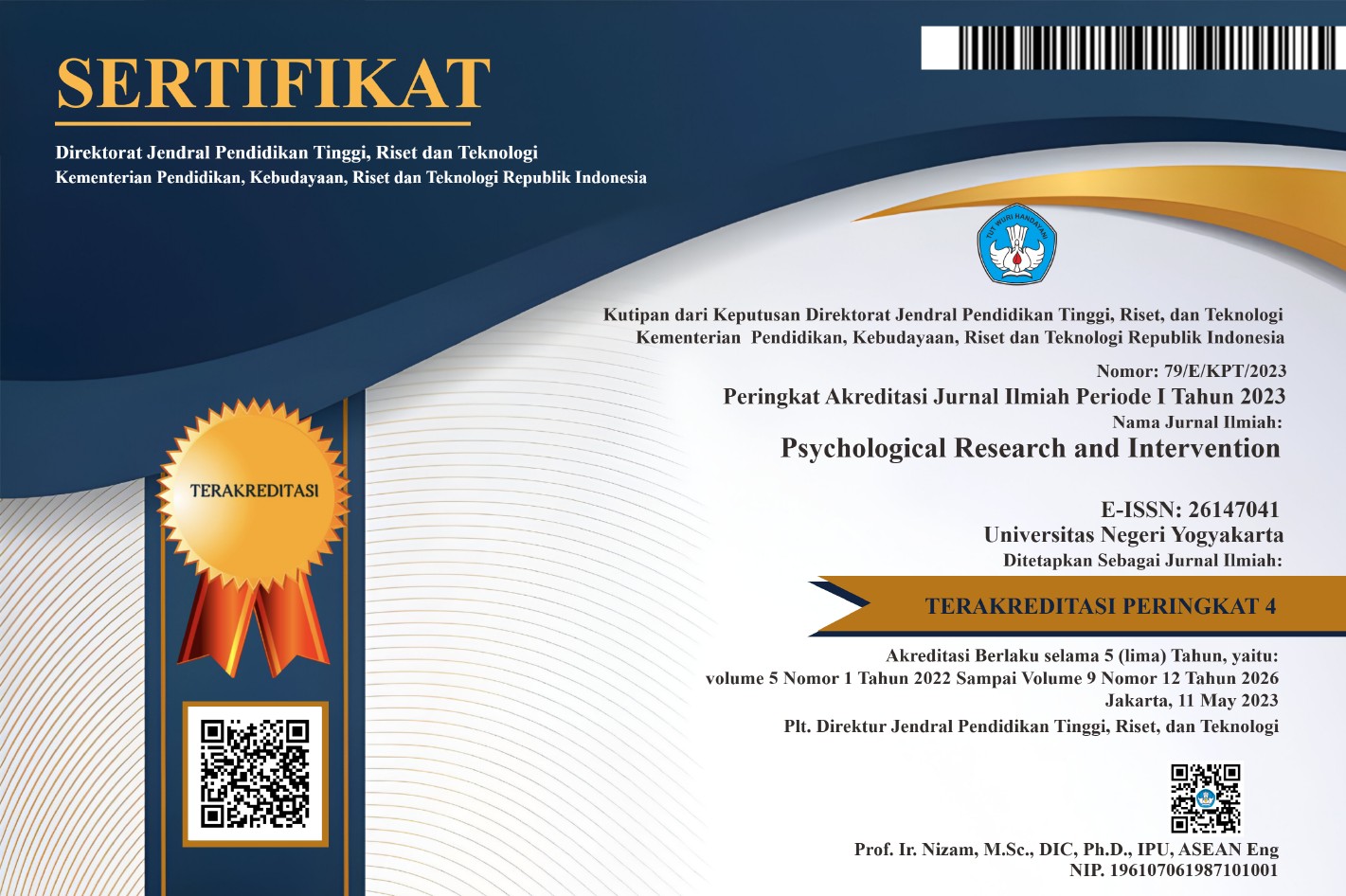Happiness in early childhood
DOI:
https://doi.org/10.21831/pri.v1i2.22024Keywords:
happiness, early childhoodAbstract
This research was conducted based on three considerations. Firstly, childhood is a critical developmental stage that forms the foundation for the psychological well-being and future learning development of children. Secondly, the prevalence of child and adolescent behavioral problems is increasing, assumed to be caused by unhappiness. Thirdly, studies related to happiness in early childhood in Indonesia are still lacking. Therefore, this study aims to explore the meaning, situation, and parties associated with happiness in children. Our study is exploratory using a qualitative approach. The respondents include 51 children aged 4 to 6 years. The research took place in the Special Region of Yogyakarta. We interviewed the respondents and later analyzed the data using content analysis. The latter consist of three coding steps: open coding, axial coding, and selective coding. The results show that, 1) the meaning of happiness refers to positive affects (55%), activities (28.9%), getting something (8.89%), positive physical conditions (4.44%), and affiliation (2.22%), 2) The situations that make children happy are activities (36.61%), learning (11.61%), entertainment (9.82%), and sports (2.62%), 3) The parties who make children happy are families (77.92%), extended families (3.90%), non-family (19.48%), God (1.30%) and toys (1.30%).
References
Aloia, L.S., & Brecht, D. (2014). Psychological well-being as a function of affectionate communication and emotional intelligence. Communication Research Reports, 34(4), 297–306. DOI: 10.1080/08824096.2017.1350570
Amato, P. (1994). Father-child relations, mother-child relations, and offspring psychological well-being in early adulthood. Journal of Marriage and the Family, 56, 1031-1042.
Anand, P. (2016). Happines, well-being and human development: The case for subjective measures. New York, NY: United Nations Development Programme.
Apache, R.R.G. (2005). Activity-based intervention in motor skill development. Perceptual and Motor Skills, 100(3), 1011–1020. DOI: 10.2466/pms.100.3c.1011-1020
Almon, J. (2003). The vital role of play in early childhood education. In S. Olfman (Ed.), All work and no play: How educational reforms are harming our preschoolers (pp. 17-42). Westport, CT: Praeger
Ash, C., & Huebner, E.S. (2001). Environmental events and life satisfaction reports of adolescents: A test of cognitive mediation. School Psychology International, 22(3), 320 -336.
Baker, J.A., Dilly, L.J., Aupperlee, J.L., & Patil, S.A. (2003). The developmental context of school satisfaction: Schools as psychologically healthy environments. School Psychology Quarterly, 18(2), 206-221. DOI: 10.1521/scpq.18.2.206.21861
Bastian, B., Kuppens, P., Roover, K.D., & Diener, E. (2014). Is valuing positive emotion associated with life satisfaction?. Emotion, 14(4), 639-645. DOI: 10.1037/a0036466
Bell, H.C., Pellis, S.M., & Kolb, B. (2010). Juvenile peer play experience and the development of the orbitofrontal and medial prefrontal cortices. Behavioural Brain Research, 207(1), 7-13. DOI: 10.1016/j.bbr.2009.09.029
Biswas-Diener, R., Diener, E., & Tamir, M. (2004). The psychology of subjective well-being. Daedalut, 133, 18-25.
Boehm, J.K., & Lyubomirsky, S. (2008). Does happines promote career success?. Journal of Career Assessment, 16(1), 101-116. DOI: 10.1177/1069072707308140
Botha, F., & Booysen, F. (2013). Family functioning and life satisfaction and happiness in South African households. Cape Town: Economic Research Southern Africa.
Bowlby, S.R. (2008). Attachment, what it is, why it is important and what we can do about it to help young children acquire a secure attachment. Verbal presentation on the theme of Attachment to the Quality of Childhood Group in the European Parliament on 8th January 2008. Retrieved from http://www.allianceforchildhood.eu/files/QOC%20Sig%204.pdf
Bowlby, J. (1988). A secure base: Clinical applications of attachment theory. London: Routledge.
Brown, S.L., Manning,W.D., & Stykes, J.B. (2015). Family structure and child well-being: Integrating family complexity. J Marriage Fam, 77(1), 177–190. DOI:10.1111/jomf.12145
Camfield, L. & McGregor, J.A. (2009). Editorial. Applied Research in Quality of Life, 4(2), 129-134. DOI: 10.1007/s11482-009-9078-6
Casby, M. W. (2003). The development of play in infants, toddlers, and young children. Communication Disorders Quarterly, 24(4), 163-174. DOI: 10.1177/15257401030240040201
Cheng, H., & Furnham, A. (2002). Personality, peer relations, and self-confidence as predictors of happiness and loneliness. Journal of Adolescence, 25(3), 327–339.DOI: 10.1006/jado.2002.0475
Creswell, J. W. (2010). Research Design: Pendekatan Kualitatif, Kuantitatif, dan Mixed (terjemahan). (A. Fawaid, Trans.) Yogyakarta: Pustaka Pelajar.
Danner, D.D., Snowdon, D.A., & Friesen, W.V. (2001). Positive emotions in early life and longevity: Findings from the nun study. Journal of Personality and Social Psychology, 80(5), 804 – 813. DOI: 10.1037/0022-3514.80.5.804
Demirbatir, R.E. (2015). Relationships between psychological well-being, happiness, and educational satisfaction in a group of university music students. Educational Research and Reviews, 10(15), 2198-2206. DOI: 10.5897/ERR2015.2375
Diener, E. (1984). Subjective well-being. Psychological Bulletin, 95(3), 542-575. DOI: 10.1037/0033-2909.95.3.542
Diener, E., & Biswas-Diener, R. (2002). Will money increase subjective well-being?. Social Indicators Research, 57(2), 119-169. DOI:10.1023/A:1014411319119
Diener, E., Lucas, R. E., & Oishi, S. (2002). Subjective well-being: The science of happiness and life satisfaction. In C. R. Snyder & S. J. Lopez (Eds.), The handbook of positive psychology (pp. 63-74). New York: Oxford University Press
Diener, E., Biswas-Diener, R. & Scollon, C.N. (2005). Seligmans' concept of positive psychology. In C.B. Fisher & R.M. Lerner (eds.). Encyclopedia of Applied Developmental Science. Thousand Oaks: Sage.
Diener, E., Fujita, F., Tay, L. & Biswas-Diener, R. (2011). Purpose, mood, and pleasure in predicting satisfaction judgements. Social Indicator Research. DOI: 10.1007/s11205-011-9787-8
Diener, E. & Gonzales, E. (2011). The validity of life satisfaction measures. Social Indicators Network News. No. 108, p.1-5.
Diener, E., Lucas, R.E., & Oishi, S. (2005). Subjective well-being. The science of happiness and life satisfaction. In C.R. Snyder & S.J. Lopez. Handbook of Positive Psychology (pp 63 – 73). New York: Oxford University Press, Inc.
Diener, E., Lucas, R.E., & Scollon, C.N. (2006). Beyond the hedonic treadmill. Revising the adaptation theory of well-being. American Psychological Association. 61(4), 305-314. DOI: 10.1037/0003-066X.61.4.305
Diener, M.L. & McGavran, M.B.D. (2008). What makes people happy? A developmental approach to the literature on family relationship and wellbeing. In M. Eid & R.J. Larsen. The science of subjective wellbeing (pp. 347-375). New York: The Guilford Press
Diener, E., Oishi, S., & Lucas, R.E. (2003). Personality, culture and subjective well-being: emotional and cognitive evaluation of life. Annual Review Psychology, 54, 403-425. DOI: 10.1146/annurev.psych.54.101601.145056
Diener, E. & Ryan, K., (tanpa tahun). Subjective well being: a general overview. South African Journal of Psychology, 39(4), 391-406
Diener, E., Tamir, M., & Scollon, C.N. (2006). Happiness, life satisfaction, and fulfillment: the social psychology of subjective well-being. In P.A.M. Van Lange. Bridging social psylochofy: Benefits of transdisciplinary approaches (pp. 319-323). New Jersey: Lawrence Erlbaum Associates Publishers.
Diener, E., Wirtz, D., Tov, W., Kim-Prieto, C., Choi, D., Oishi, S. & Biswas-Diener, R. (2010). New well-being measures: short scale to asses flourishing and positive and negative feelings. Social Indicator Research, 97, 143-156. DOI: 10.1007/s11205-009-9493
Dush, C.M.K., & Amato, P.R. (2005). Consequences of relationship status and quality for subjective well-being. Journal of Social and Personal Relationship, 22(5), 607-627. DOI: 10.1177/0265407505056438
Edwards, S.D, Ngcobo, H.S.B, Edwards, D.J., & Palavar, K. (2005). Exploring the relationship between physical activity, psychological well-being and physical self-perception in different exercise groups. South African Journal for Research in Sport, Physical Education and Recreation, 27(1), 59-74
Ejieh M. U. C. (2006). Pre-primary education in nigeria: Policy implementation and problems. Elementary Education Online, 5(1) 58 – 64.
Eryılmaz, A. (2015). Positive psychology in the class: The effectiveness of a teaching method based on subjective well-being and engagement increasing activities. International Journal of Instruction, 8(2), 17-32. DOI: 10.12973/iji.2015.822a
Eryılmaz, A. (2012). A model of subjective well-being for adolescents in high school. Journal of Happines Studies, 13(2), 275-289. DOI: 10.1007/s10902-011-9263-9
Ghasempour, A., Jodat, H., Soleimani, M., Shabanlo, K.Z. (2013). Happiness as a predictor of psychological well-being of male athlete students. Annals of Applied Sport Science, 1(2), 25-32
Gilligan, M., Suitor, J.J., Nam, S., Routh, B., Rurka, M., & Con, G. (2017). Family networks and psychological well-being in midlife. Soc. Sci, 6(3), 1-14. DOI: 10.3390/socsci6030094
Gleave, J., & Cole-Hamilton, I. (2012). A world without play: A literature review (A literature review on the effects of a lack of play on children's lives). London: British Toy & Hobby Association.
Grant, A.M., Christianson, M.K., & Price, R.H. (2007). Happiness, health, or relationships? Managerial practices and employee well-being tradeoffs. Academy of Management Perspectives, 21(3), 51-63. DOI: 10.5465/amp.2007.26421238
Goldstein, J. (2012). Play in Children's development, health and well-being. Toy Inducstries of Europe (TIE): Brussels.
Guney, S. (2009) Life satisfaction of university students in Turkey, poster, 1st World Positive Psychology Conference, Pennsylvania, USA, 18-23 June
Haney, M. and Bissonnette, V. (2011). Teachers' Perceptions about the Use of Play to Facilitate Development and Teach Pro-social Skills. Journal of Creative Education, 2 (1), 41-46. DOI: 10.4236/ce.2011.21006
Holder, M.D., & Coleman, B. (2009). The contribution of social relationship to children's happiness. J. Happiness Stud, 10(3), 329-349. DOI 10.1007/s10902-007-9083-0
Husted, H.S. (2017). The relationship between psychological well-being and successfully transitioning to university (Master's thesis, King's University College at Western University, Ontario). Retrieved from https://ir.lib.uwo.ca/cgi/viewcontent.cgi?article=1062&context=psychK_uht
Indumathy, J., & Ashwini, K. (2017). Parental Bonding and Psychological Well-Being among Young Adults. The International Journal of Indian Psychology, 4(2), 77-85.
Keyes, C.L.M. (2009). The nature and importance of positive mental health in America's adolescents. In R. Gilman, E.S. Huebner, & M.J. Furlong. Handbook of positive psychology in schools (pp. 9–23). New York: Routledge.
Keyes, L.M., Shmotkin, D., & Ryff, C.D. (2002). Optimizing well-being: The empirical encounter of two traditions. Journal of Personality and Social Psychology, 8(6), 1007-1022
Kuo, Y., Liao, H., Chen, P., Hsieh, W., & Hwang, A. (2008). The influence of wakeful prone positioning on motor development during the early life. Journal of Developmental and Behavioral Pediatrics, 29(5), 367-376. DOI; 10.1097/DBP.0b013e3181856d54
Kuppens, P., Realo, A., & Diener, E. (2008). Role of Positive and Negative Emotions in Life Satisfaction Judgment Across Nations. Journal of Personality and Social Psychology, 95(1), 66 –75. DOI: 10.1037/0022-3514.95.1.66
Lyubomirsky, S., Sheldon, K. M., & Schkade, D. (2005). Pursuing happiness: The architecture of sustainable change. Review of General Psychology, 9(2), 111-131. DOI: 10.1037/1089-2680.9.2.111
Lyubomirsky, S., & King, L. (2005). The benefits of frequent positive affect: does happiness lead to succes. Psychological Bulletin, 131(6), 803-855. DOI: 10.1037/0033-2909.131.6.803
Mallers, M.H., Charles, S.T., Neupert, S.D., & Almeida, D.M. (2010). Perceptions of childhood relationships with mother and father: Daily emotional and stressor experiences in adulthood. Dev Psychol, 46(6), 1651–1661. DOI: 10.1037/a0021020.
Manago A., & Vaughn L. (2015). Social media, friendship, and happiness in the millennial generation. In Demir M. (eds), Friendship and happiness (pp. 187-204). Springer: Dordrecht.
Martín, J.S., Perles, F., & Canto, J.M. (2010). Life satisfaction and perception of happiness among university students. The Spanish Journal of Psychology, 13(2), 617-628.
Nairn, A., & IPSOS MORI Social Research Institute. (2011). Children's well-being in UK, Sweden and Spain: The role of inequality and materialism: A qualitative study. London: IPSOS MORI Social Research Institute.
NSW Goverment. (2015). The wellbeing framework for schools. Sydney, NSW: NSW Department of Education and Communities.
Ogunyemi, F.T. & Ragpot, L. (2015). Work and play in early childhood education: Views from Nigeria and South Africa. South African Journal of Childhood Education, 5(3), 1-7. DOI: 10.4102/sajce. v5i3.344
Pannilage, U. (2017). Impact of family on children's wellbeing. Journal of Sociology and Social Work, 5(1), 149-158. DOI: 10.15640/jssw.v5n1a15
Pate, R.P., Dowda, M., Brown, W.H., Mitchell, J., & Addy, C. (2013). Physical activity in preschool children with the transition to outdoors. Journal of Physical Activity and Health, 10(2), 170-175. DOI: 10.1123/jpah.10.2.170
Putri, L. Y. E. & Wicaksono, B. (2017). Contoh Operasional Penelitian Indigenous Psychology. In Faturochman, W. M. Minza, & T. A. Nurjaman (Eds.). Memahami dan Mengembangkan Indigenous Psychology (pp. 79-110). Yogyakarta: Pustaka Pelajar.
Poerwandari, K. (1998). Pendekatan Kualitatif untuk Penelitian Perilaku Manusia. Jakarta: Fakultas Psikologi Universitas Indonesia.
Rabito-Alcon & Rodriguez-Molina, (2016). Satisfaction with life and psychological well-being in people with gender dysphoria. Actas Esp Psiquiatr, 44(2), 47-54.
Reunamo, J., Hakala, L., Saros, L., Lehto, S., Kyhala, A., Valtonen, J. (2014). Children's physical activity in day care and preschool. Early Years, 34(1), 32-48. DOI: 10.1080/09575146.2013.843507
Rojas, M. (2008). Experienced poverty and income poverty in mexico: a subjective well-being approach. World Development, 36(6), 1078–1093. DOI: 10.1016/j.worlddev.2007.10.005
Ruini, C., Vescovelli, F., Carpi, V., & Masoni, L. (2017) Exploring psychological well-being and positive emotions in school children using a narrative approach. Indo-Pacific Journal of Phenomenology, 17(1), 1-9, DOI: 10.1080/20797222.2017.129928
Ryan, R.M., & Deci, E.L. (2001). On happiness and human potentials: A review of research on hedonic and eudemonic well-being. Annual Review of Psychology, 52, 141–166.
Ryff, C.D. (2014). Psychological well-being revisited: Advances in science and practice. Psychother Psychosom, 83(1), 10–28. DOI: 10.1159/000353263.
Ryff C.D., & Singer, B.H. (2006). Best news yet on the six-factor model of well-being. Social Science Research, 35, 1103–19. DOI: 10.1016/j.ssresearch.2006.01.002
Ryff, C.D., & Keyes, C.L.M. (1995). The structure of psychological well-being revisited. Journal of Personality and Social Psychology, 69(4), 719-727.
Saphire-Bernstein, S., & Taylor, S.E. (2013).Close relationships and happiness . In I. Boniwell, S.A. David, & A.C. Ayers (eds), Oxford handbook of happiness (pp. 821-833). Oxford University Press: Oxford, UK.
Sarantakos, S. (2005). Social research (3rd Ed). New York: Palgrave Macmillan.
Sharif, S. (2014). School playground: Its impact on children's learning and development. Singapore: Asia-Pasific Regional Network for Early Childhood.
Seligman, M. E. P., Steen, T. A., Park, N., & Peterson, C. (2005). Positive psychology progress: Empirical validation of interventions. American Psychologist, 60(5), 410-421.DOI: 10.1037/0003-066X.60.5.410
Seligman, M.E.P. (2002). Authentic happiness: Using the new positive psychology to realize your potential for lasting fulfillment. New York: Free Press.
Singer, E. (2015). Play and playfulness in early childhood education and care. Psychology in Russia: State of the Art, 8(2), 27-35. DOI: 10.11621/pir.2015.0203
Singer, E. (2013). Play and playfulness, basic features of early childhood education. European Early Childhood Education Research Journal, 21(2), 172-184. DOI: 10.1080/1350293X.2013.789198
Singh, K., & Jha, S.D. (2008). Positive and negative affect, and grit as predictors of happiness and life satisfaction. Journal of the Indian Academy of Applied Psychology, 34, 40-45
Snyder, C.R., & Lopez, S.J. (2007). Positive psychology: The scientific and practical explorations of human strength. Thousand Oaks, CA: Sage Publication.
Stafford, M., Kuh, D.L., Gale, C.R., Mishra, G., & Richards, M. (2016). Parent–child relationships and offspring's positive mental wellbeing from adolescence to early older age. The Journal of Positive Psychology, 11(3), 326-337. DOI: 10.1080/17439760.2015.1081971
Statham, J., & Chase, E. (2010). Childhood wellbeing: A brief overview. London: Institute of Education, Loughborough University & University of Kent.
Stradzdins, L., Lucas, N., Shipley, M., Mathews, R., Berry, H., Rodgers, B., & Davies, A. (2011). Parent and child wellbeing and the influence of work and family arrangements: a three cohort study. Canberra: Australian Government Department of Families, Housing, Community Services and Indigenous Affairs.
The Children's Society. (2012). Promoting positive well-being for children: A report for decision-makers in parliament, central government and local areas. London: The Children's Society.
Thompson, S., & Aked, J. (2009). A guide to measuring children's well-being. London: New Economics Foundation.
Tremblay, L., Boudreau-Lariviere, C., & Cimon-Lambert, K. (2012). Promoting physical activity in preschoolers: a review of the guidelines, barriers, and facilitators for implementation of policies and practices. Canadian Psychology, 53(4), 280 –290. DOI: 10.1037/a0030210
Tucker, P. (2008). The physical activity levels of preschool-aged children: A systematic review. Early Childhood Research Quarterly, 23, 547-558. DOI: 10.1016/j.ecresq.2008.08.005
UNICEF. (2016). Early childhood development: The key to a full and productive life. New York: UNICEF.
Veitch, J., Salmon, J., & Ball, K. (2010). Individual, social and physical environmental correlates of children's active free-play: a cross-sectional study. International Journal of Behavioral Nutrition and Physical Activity, 7(11) 1 – 10. DOI: 10.1186/1479-5868-7-11
Whitebread, D., Basilio, M., Kuvalja, M., & Verma, M. (2012). The importance of play. Toy Inducstries of Europe (TIE): Brussels.












